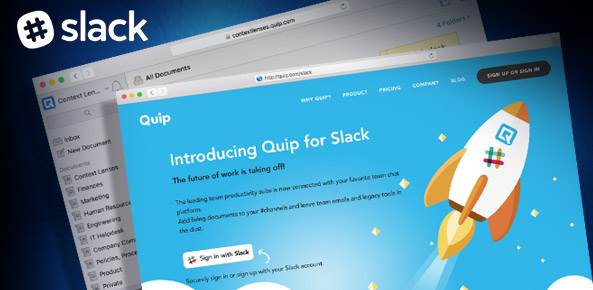The workplace chat app Slack is making a move to leave a mark on enterprise apps of all kinds. Today, the company announced that it’s rolling out a new feature called Sign in with Slack.
The feature lets Slack users sign into and use other apps with the same identities they use with Slack. Sign in with Slack is a way to keep teams connected across the many apps they use for work, the company said.
The advantages of the new feature in Slack are that it lets administrators log team members in without a lot of repeated steps; it’s quickly implemented and easy to understand; and its capacity for two-factor authentication confirms e-mail addresses and eases security concerns, according to the company.
Partnered With Quip
According to a post on Slack’s Web site, people can now use Sign in with Slack to log into Quip, a document creation application. Users can then give their existing Slack team members access to Quip documents and lists, as well as converting Slack chats into Quip documents. Figma, Kifi, OfficeVibe, Slackline and Smooz have also integrated their apps with Slack, the company said.
The sign-on features are built on the OAuth authentication standard — which is used across the entire Slack platform. OAuth assures that users are who they say they are, and lets them preserve their online identities across multiple apps and Web sites.
The idea is similar to how Facebook, Google, and Twitter let users sign in with their login information from those platforms. However, the difference is that Sign in with Slack is intended for work and school applications more so than social applications.
Positive Development
Forrester Inc. analyst Craig Le Clair told us Sign in with Slack is a positive development for Slack and its users. “The more a collaboration app can help get real work done, the more valuable [it is],” Le Clair said. “For Slack, this allows them to push outside of the developer and tech management community to the broader workplace.”
Le Clair noted that over time the new feature might collide with enterprise-ready functions, such as Citrix and Okta, that unlock the core systems that drive enterprise productivity. However, Sign in with Slack has potential, he said.
Slack is small but growing rapidly, now boasting 2.7 million daily active users and 800,000 paid seats. These figures represent more than a threefold growth from a year ago. The company appears to be counting on the continuation of the trend of corporations moving away from e-mail in favor of instant communications.
The ability of Sign in with Slack to work with numerous productivity apps might give it a leg up as it tries to pass Facebook and Google as the sign-in service of choice for enterprises, schools and other settings.
Image Credit: Screenshot of Slack Debuts Cross-App Sign-in Feature via Quip/Slack.







